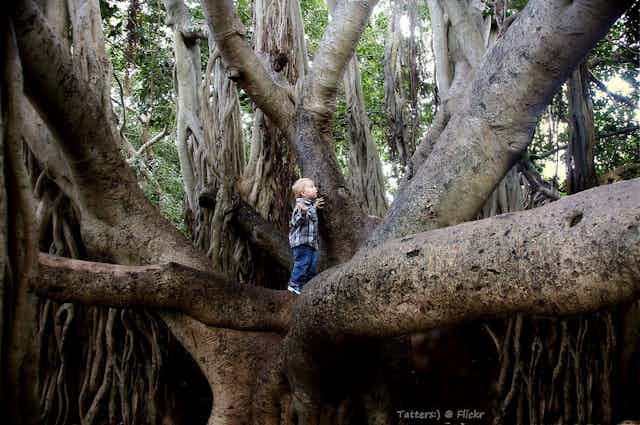We know that trees have many benefits. In forests they provide habitat, wood, biodiversity and ecosystem services. In cities, they can mitigate the urban heat island effect by cooling the air and reducing greenhouse gases.
But, perhaps surprisingly, there is increasing evidence that trees are also good for our mental health.
Are we all tree-huggers?
The idea that humans are intimately connected to the earth has persisted throughout human history and across cultures. In the western world, this connection was most recently described by eminent biogeographer E.O. Wilson in his 1984 book Biophilia. Wilson notes that humans naturally like to be around other living things.
This theory helps to explain why people prefer green scenes to urban scenes, why pet owners are happier and healthier, and possibly why we’re so obsessed with cute and cuddly animals.
This hypothesis was the basis of “connection to nature”. Psychologists have now developed multiple scales used by researchers to determine how connected a person is, and how we might be able to increase our connection to our benefit.
Connection to nature research is still developing, but early results seem to indicate that how connected to nature you are is related to your environmental behaviours, such as participation in recycling programs and an increase in overall well-being and happiness.
Because it is still a new line of research, the relative connection to nature of folks who live in urban areas and cities versus those of us living in rural places has yet to be established. But many researchers and environmental educators have come to suspect that we are becoming disconnected from nature.

Nature-deficit disorder
This disconnect from nature was set out in 2005 by American writer Richard Louv in his book The Last Child in the Woods. Louv coined the term “nature-deficit disorder” which means that modern humans have become disconnected from nature through our daily activities and this disconnect has had negative consequences in terms of mental and physical health. Proof of this hypothesis so far lies in studies that show how people with “modern” ailments, such as ADHD, anxiety or depression feel better with exposure to nature.
Based in North America, the Children & Nature Network has pages and pages of summarised research from academics around the world that seems to indicate a strong likelihood this disconnect is a real phenomenon. The sheer number of studies and their results showing the miracle cure of nature can be overwhelming at times.
There are studies represented such as:
- Living in urban areas with more tree canopy cover had increased the likeliness of a better birth outcome.
- Inner city girls with a greater view of green from their high-rise public housing buildings had more self-discipline than their peers who look at other buildings.
- Children with ADHD receive the greatest relief of symptoms through participation in green outdoor activities versus other activities without nature.
- Just choosing the natural path on your way across campus can increase your positive emotions.
- The pioneering study by Ulrich in 1984 that showed patients recovered from surgery faster and with fewer complaints when placed in a room with a natural view out the window versus looking onto a brick wall.
Do yourself a favour, skim the pages of research summarised in short abstract form on the Children & Nature Network website. You may start to wonder why we’re not hearing more about getting our children and ourselves back outside.
This research also clearly highlights the important role that urban trees play in cities: their enormous social and psychological benefits may be even greater than ecological benefits.

Reconnecting with the natural world
So what are our next steps? As I see it, there are two things that must be done.
First, as researchers we really need to directly test the idea of a disconnect particularly between urban/built up areas and more rural areas with plentiful trees. We need to know if people living in areas with fewer trees and natural environments are more disconnected from nature than those living in places where there are abundant trees and wildlife. Deeper still, we could also ask what interventions seem to connect folks to nature in a meaningful way?
Second and most importantly, if we are disconnected from nature, what can we do about it? Fortunately the above studies and resources show us many different activities and ideas we can use to increase our nature exposure.
Just a few ideas to try:
Bring a plant into your office.
Ask council to plant a street tree outside your office window or better yet all around town.
When walking, choose the path through the park instead of around it.
Take your children to the park, to the natural sections as well as the play equipment.
Practise the art of gardening or even veggie gardening.
Plant a tree.
Spend some time sitting under a tree. And if you’re so inclined, maybe even give it a cuddle.

